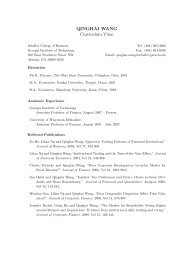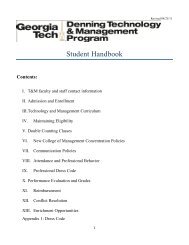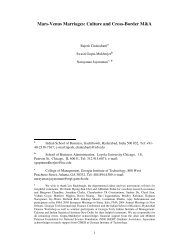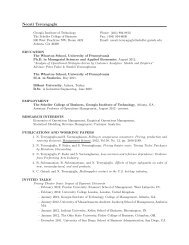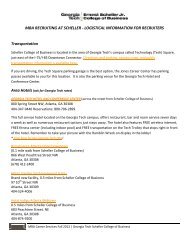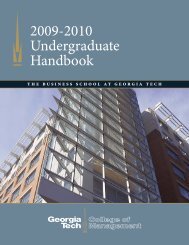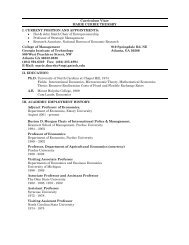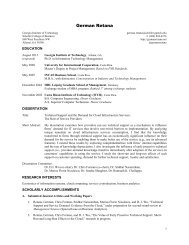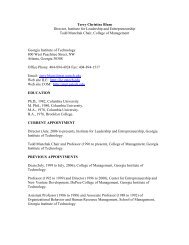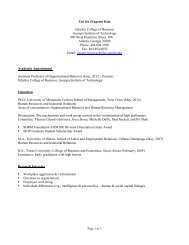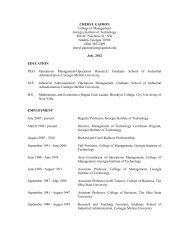Changes in Accounting for Negative Goodwill: New Insights into ...
Changes in Accounting for Negative Goodwill: New Insights into ...
Changes in Accounting for Negative Goodwill: New Insights into ...
You also want an ePaper? Increase the reach of your titles
YUMPU automatically turns print PDFs into web optimized ePapers that Google loves.
Georgia Tech F<strong>in</strong>ancial Analysis Lab<br />
800 West Peachtree Street NW<br />
Atlanta, GA 30332-0520<br />
404-894-4395<br />
http://www.mgt.gatech.edu/f<strong>in</strong>lab<br />
Dr. Charles W. Mul<strong>for</strong>d, Director Dr. Eugene E. Comiskey<br />
Invesco Chair and Professor of Account<strong>in</strong>g Callaway Chair and Professor of Account<strong>in</strong>g<br />
charles.mul<strong>for</strong>d@mgt.gatech.edu eugene.comiskey@mgt.gatech.edu<br />
<strong>Changes</strong> <strong>in</strong> Account<strong>in</strong>g <strong>for</strong> <strong>Negative</strong> <strong>Goodwill</strong>:<br />
<strong>New</strong> <strong>Insights</strong> <strong>in</strong>to Barga<strong>in</strong> Purchase Transactions<br />
Why Sell <strong>for</strong> Less Than Fair Value?<br />
Executive Summary<br />
SFAS 141(R), Bus<strong>in</strong>ess Comb<strong>in</strong>ations, <strong>in</strong>cludes significant changes to the account<strong>in</strong>g and disclosure<br />
requirements <strong>for</strong> acquisitions made at less than fair value. Under new rules, acquisition-related ga<strong>in</strong>s,<br />
asset valuations and shareholders’ equity will be higher <strong>in</strong> transactions yield<strong>in</strong>g negative goodwill, a<br />
f<strong>in</strong>ancial statement element referred to hence<strong>for</strong>th as a barga<strong>in</strong> purchase amount. In years after the<br />
acquisition, operat<strong>in</strong>g earn<strong>in</strong>gs will be reduced as <strong>in</strong>creased asset valuations are amortized or<br />
depreciated.<br />
Disclosure requirements conta<strong>in</strong>ed <strong>in</strong> the revised standard provide f<strong>in</strong>ancial statement readers with new<br />
<strong>in</strong>sights <strong>in</strong>to why firms are able to effect acquisitions at less than fair value. In review<strong>in</strong>g 71<br />
acquisitions, we f<strong>in</strong>d several reasons <strong>for</strong> the existence of such barga<strong>in</strong> purchase ga<strong>in</strong>s, rang<strong>in</strong>g from<br />
f<strong>in</strong>ancial distress of the target, to special characteristics of the acquir<strong>in</strong>g firm, to flaws <strong>in</strong> the bidd<strong>in</strong>g<br />
process. These f<strong>in</strong>d<strong>in</strong>gs have implications <strong>for</strong> <strong>in</strong>vestors, who must analyze barga<strong>in</strong> purchase<br />
transactions, <strong>for</strong> CFOs and other corporate managers, who must implement the new standard’s<br />
provisions, and <strong>for</strong> regulators, who must determ<strong>in</strong>e whether the new standard is be<strong>in</strong>g properly applied.<br />
April 2011
Georgia Tech F<strong>in</strong>ancial Analysis Lab www.mgt.gatech.edu/f<strong>in</strong>lab<br />
Georgia Tech F<strong>in</strong>ancial Analysis Lab<br />
Georgia Tech F<strong>in</strong>ancial Analysis Lab<br />
College of Management<br />
Georgia Institute of Technology<br />
Atlanta, GA 30332-0520<br />
The Georgia Tech F<strong>in</strong>ancial Analysis Lab conducts unbiased stock market research.<br />
Unbiased <strong>in</strong><strong>for</strong>mation is vital to effective <strong>in</strong>vestment decision-mak<strong>in</strong>g. Accord<strong>in</strong>gly,<br />
<strong>in</strong>dependent research organizations, such as this Lab, have an important role to play <strong>in</strong><br />
provid<strong>in</strong>g <strong>in</strong><strong>for</strong>mation to market participants.<br />
Because the Lab is housed with<strong>in</strong> a university, all of its research reports have an educational<br />
quality, as they are designed to impart knowledge and understand<strong>in</strong>g to those who read them.<br />
Its focus is on issues that it believes will be of <strong>in</strong>terest to a large segment of stock market<br />
participants. Depend<strong>in</strong>g on the issue, the Lab may focus its attention on <strong>in</strong>dividual<br />
companies, groups of companies, or on large segments of the market at large.<br />
A recurr<strong>in</strong>g theme <strong>in</strong> Lab´s work is the identification of report<strong>in</strong>g practices that give <strong>in</strong>vestors<br />
a mislead<strong>in</strong>g signal, whether positive or negative, of corporate earn<strong>in</strong>g power. It def<strong>in</strong>es<br />
earn<strong>in</strong>g power as the ability to generate a susta<strong>in</strong>able stream of earn<strong>in</strong>gs that is backed by<br />
cash flow. Accord<strong>in</strong>gly, the Lab research may look <strong>in</strong>to report<strong>in</strong>g practices that affect either<br />
earn<strong>in</strong>gs or cash flow, or both. At times, its research may look at stock prices generally,<br />
though from a fundamental and not technical po<strong>in</strong>t of view.<br />
Contact In<strong>for</strong>mation<br />
Charles Mul<strong>for</strong>d Invesco Chair, Professor of Account<strong>in</strong>g and the Lab's Director<br />
Phone: (404) 894-4395<br />
Email: charles.mul<strong>for</strong>d@mgt.gatech.edu<br />
Brandon Miller Graduate Research Assistant and MBA Student<br />
Ariadna Lopez de Mesa Graduate Research Assistant and MBA Student<br />
Website: http://www.mgt.gatech.edu/f<strong>in</strong>lab<br />
©2011 by the College of Management, Georgia Institute of Technology, Atlanta, GA<br />
30332-0520. ALL RIGHTS RESERVED. The <strong>in</strong><strong>for</strong>mation conta<strong>in</strong>ed <strong>in</strong> this research<br />
report is solely the op<strong>in</strong>ion of the authors and is based on sources believed to be reliable<br />
and accurate, consist<strong>in</strong>g pr<strong>in</strong>cipally of required fil<strong>in</strong>gs submitted by the companies<br />
represented to the Securities and Exchange Commission. HOWEVER, ALL<br />
CONTENT HEREIN IS PRESENTED "AS IS", WITHOUT WARRANTIES OF ANY<br />
KIND, EXPRESS OR IMPLIED. No data or statement is or should be construed to be a<br />
recommendation <strong>for</strong> the purchase, retention, sale or short-sale of the securities of the<br />
companies mentioned.<br />
<strong>Changes</strong> <strong>in</strong> Account<strong>in</strong>g <strong>for</strong> <strong>Negative</strong> <strong>Goodwill</strong>: <strong>New</strong> <strong>Insights</strong> <strong>in</strong>to Barga<strong>in</strong> Purchase Transactions. Why Sell <strong>for</strong><br />
Less Than Fair Value? April 2011 (c) 2011 by the College of Management, Georgia Institute of Technology,<br />
Atlanta, GA 30332-0520. 2
Georgia Tech F<strong>in</strong>ancial Analysis Lab www.mgt.gatech.edu/f<strong>in</strong>lab<br />
<strong>Changes</strong> <strong>in</strong> Account<strong>in</strong>g <strong>for</strong> <strong>Negative</strong> <strong>Goodwill</strong>:<br />
<strong>New</strong> <strong>Insights</strong> <strong>in</strong>to Barga<strong>in</strong> Purchase Transactions<br />
Why Sell <strong>for</strong> Less Than Fair Value?<br />
Companies Explicitly Mentioned <strong>in</strong> This Report<br />
Company Page<br />
AGY Hold<strong>in</strong>g Corp. 18<br />
Alamo Group, Inc. 10, 18<br />
Astro-Med, Inc. 15<br />
BFC F<strong>in</strong>ancial Corp. 18<br />
City National Corp. 16<br />
Corn<strong>in</strong>g, Inc. 7, 18<br />
East West Bancorp, Inc. 16<br />
EDAC Technologies Corp. 18<br />
Evans Bancorp., Inc. 16<br />
First Citizens Bancshares, Inc. 16<br />
FirstCity F<strong>in</strong>ancial Corp. 18<br />
Flowers Foods, Inc. 19<br />
GSI Technology, Inc. 19<br />
H.D. Supply Inc. 19<br />
JPMorgan Chase & Co. 8<br />
K<strong>in</strong>gstone Companies, Inc. 15<br />
Leucadia National Corp. 19<br />
Manitex International, Inc. 19<br />
Millipore Corp. 20<br />
Netezza Corp. 15<br />
<strong>New</strong> York Community Bancorp, Inc. 13, 16<br />
NIC, Inc. 20<br />
Pre<strong>for</strong>med L<strong>in</strong>e Products Co. 20<br />
Pernix Group, Inc. 20<br />
RadNet, Inc. 20<br />
Republic Airways Hold<strong>in</strong>g 21<br />
Sonosite Inc. 15<br />
Superior Energy Services, Inc. 22<br />
Tri City Bankshares Corp. 17<br />
Warwick Valley Telephone 22<br />
WestAmerica Bancorporation 17<br />
Wilshire Bancorp Inc. 17<br />
Zion Bancorporation 17<br />
<strong>Changes</strong> <strong>in</strong> Account<strong>in</strong>g <strong>for</strong> <strong>Negative</strong> <strong>Goodwill</strong>: <strong>New</strong> <strong>Insights</strong> <strong>in</strong>to Barga<strong>in</strong> Purchase Transactions. Why Sell <strong>for</strong><br />
Less Than Fair Value? April 2011 (c) 2011 by the College of Management, Georgia Institute of Technology,<br />
Atlanta, GA 30332-0520. 3
Georgia Tech F<strong>in</strong>ancial Analysis Lab www.mgt.gatech.edu/f<strong>in</strong>lab<br />
Other Companies with Barga<strong>in</strong> Purchase Ga<strong>in</strong>s <strong>in</strong> 2009<br />
Acme Packet, Inc.<br />
Advanced Battery Technologies, Inc.<br />
Alliance Data Systems Corp.<br />
Ameris Bancorp<br />
Audiovox Corp.<br />
Bruker Corp.<br />
Cephalon, Inc.<br />
Chart Industries, Inc.<br />
CMG Hold<strong>in</strong>gs, Inc.<br />
CVB F<strong>in</strong>ancial Corp.<br />
EnerSys<br />
Entegris, Inc.<br />
Equity One, Inc.<br />
First Bancorp<br />
First Community Bancshares Inc.<br />
First F<strong>in</strong>ancial Bancorp<br />
First United Bancorp, Inc.<br />
Four Oaks F<strong>in</strong>corp, Inc.<br />
Fuel Systems Solutions, Inc.<br />
Genzyme Corp.<br />
Glacier Bancorp. Inc.<br />
Hancock Hold<strong>in</strong>g Co.<br />
Heartland F<strong>in</strong>ancial USA, Inc.<br />
Iberiabank Corp.<br />
INCON Income Fund Ten, LLC<br />
JMP Group, Inc.<br />
Keyon Communications Hold<strong>in</strong>gs, Inc.<br />
Kit Digital, Inc.<br />
Motorcar Parts of America, Inc.<br />
Nash–F<strong>in</strong>ch Co.<br />
Noranda Alum<strong>in</strong>um, Inc.<br />
PacWest Bancorp<br />
Premier F<strong>in</strong>ancial Bancorp, Inc.<br />
Sound F<strong>in</strong>ancial, Inc.<br />
Southern National Bancorp of Virg<strong>in</strong>ia, Inc.<br />
Southwest Bancorp, Inc.<br />
StoneMor Partners L.P.<br />
Syms Corp.<br />
VMware, Inc.<br />
<strong>Changes</strong> <strong>in</strong> Account<strong>in</strong>g <strong>for</strong> <strong>Negative</strong> <strong>Goodwill</strong>: <strong>New</strong> <strong>Insights</strong> <strong>in</strong>to Barga<strong>in</strong> Purchase Transactions. Why Sell <strong>for</strong><br />
Less Than Fair Value? April 2011 (c) 2011 by the College of Management, Georgia Institute of Technology,<br />
Atlanta, GA 30332-0520. 4
Georgia Tech F<strong>in</strong>ancial Analysis Lab www.mgt.gatech.edu/f<strong>in</strong>lab<br />
<strong>Changes</strong> <strong>in</strong> Account<strong>in</strong>g <strong>for</strong> <strong>Negative</strong> <strong>Goodwill</strong>:<br />
<strong>New</strong> <strong>Insights</strong> <strong>in</strong>to Barga<strong>in</strong> Purchase Transactions<br />
Why Sell <strong>for</strong> Less Than Fair Value?<br />
By Eugene E. Comiskey and Charles W. Mul<strong>for</strong>d<br />
Introduction<br />
In 2009 we saw important changes to the account<strong>in</strong>g <strong>for</strong> acquisitions entail<strong>in</strong>g negative<br />
goodwill. In these transactions, the fair value of the net assets acquired <strong>in</strong> a bus<strong>in</strong>ess<br />
comb<strong>in</strong>ation exceeds the purchase price. In effect, the bus<strong>in</strong>ess is acquired <strong>for</strong> less than its<br />
fair value – a barga<strong>in</strong>. Historically, the reasons <strong>for</strong> such barga<strong>in</strong> purchase transactions<br />
typically were not provided and the f<strong>in</strong>ancial statement effects were not particularly clear.<br />
With changes <strong>in</strong>troduced by SFAS No. 141(R), Bus<strong>in</strong>ess Comb<strong>in</strong>ations, such f<strong>in</strong>ancial<br />
statement shortcom<strong>in</strong>gs have now been addressed. 1 Disclosures made by firms account<strong>in</strong>g<br />
<strong>for</strong> bus<strong>in</strong>ess comb<strong>in</strong>ations under the new report<strong>in</strong>g standard provide useful <strong>in</strong>sight <strong>in</strong>to the<br />
reasons <strong>for</strong> and the f<strong>in</strong>ancial statement effects of barga<strong>in</strong> purchase transactions.<br />
Under previous account<strong>in</strong>g guidance, negative goodwill, or the amount by which the fair<br />
value of net assets acquired exceeded the purchase price, was first used to reduce the fair<br />
values assigned to certa<strong>in</strong> acquired assets. These assets, referred to as allocation assets, were<br />
typically more difficult to value and <strong>in</strong>cluded mostly noncurrent, non-f<strong>in</strong>ancial assets such as<br />
land, build<strong>in</strong>gs, equipment and <strong>in</strong>tangibles. In effect, the th<strong>in</strong>k<strong>in</strong>g at the time was not to<br />
accept, at face value, the existence of a barga<strong>in</strong> purchase, but rather to treat it as an<br />
account<strong>in</strong>g fiction that arose because of an improper valuation of certa<strong>in</strong> hard-to-value assets.<br />
No ga<strong>in</strong> on the transaction was recorded unless the amount of the barga<strong>in</strong> purchase exceeded<br />
the fair values of all such allocation assets. Then, <strong>in</strong> account<strong>in</strong>g <strong>for</strong> the acquisition, the<br />
values assigned to those difficult-to-value assets would be reduced to zero and a ga<strong>in</strong> would<br />
be recorded <strong>for</strong> any rema<strong>in</strong><strong>in</strong>g barga<strong>in</strong> purchase amount.<br />
While no ga<strong>in</strong> was recorded <strong>in</strong> the year of acquisition to the extent that allocation assets were<br />
reduced <strong>for</strong> the amount of any negative goodwill, that ga<strong>in</strong> did f<strong>in</strong>d its way <strong>in</strong>to <strong>in</strong>come <strong>in</strong><br />
future years. That is, lower asset values led to lower expense charges through reduced<br />
amortization or depreciation over time, rais<strong>in</strong>g operat<strong>in</strong>g <strong>in</strong>come.<br />
With the <strong>in</strong>troduction of the revised version of SFAS No. 141, there is no longer any<br />
allocation of negative goodwill, which is now officially referred to as the barga<strong>in</strong> purchase<br />
amount, aga<strong>in</strong>st allocation assets. Rather, now the entire barga<strong>in</strong>-purchase amount is reported<br />
as a ga<strong>in</strong> on the <strong>in</strong>come statement and is treated as a component of earn<strong>in</strong>gs be<strong>for</strong>e<br />
extraord<strong>in</strong>ary items. 2<br />
1 Statement of F<strong>in</strong>ancial Account<strong>in</strong>g Standards (SFAS) No. 141(R), Bus<strong>in</strong>ess Comb<strong>in</strong>ations, (Norwalk, CT:<br />
F<strong>in</strong>ancial Account<strong>in</strong>g Standards Board, December, 2007). The content of the account<strong>in</strong>g standard is conta<strong>in</strong>ed<br />
<strong>in</strong> Topic 805, Bus<strong>in</strong>ess Comb<strong>in</strong>ations, of the FASB Account<strong>in</strong>g Standards Codification.<br />
2 For more background on the treatment of negative goodwill (barga<strong>in</strong> purchases) over the years, see Eugene E.<br />
Comiskey and Charles W. Mul<strong>for</strong>d. 2008. <strong>Negative</strong> <strong>Goodwill</strong>: Issues of F<strong>in</strong>ancial Report<strong>in</strong>g and Analysis Under<br />
Current and Proposed Guidel<strong>in</strong>es. The Journal of Applied Research <strong>in</strong> Account<strong>in</strong>g and F<strong>in</strong>ance 3 (1): 33-42.<br />
<strong>Changes</strong> <strong>in</strong> Account<strong>in</strong>g <strong>for</strong> <strong>Negative</strong> <strong>Goodwill</strong>: <strong>New</strong> <strong>Insights</strong> <strong>in</strong>to Barga<strong>in</strong> Purchase Transactions. Why Sell <strong>for</strong><br />
Less Than Fair Value? April 2011 (c) 2011 by the College of Management, Georgia Institute of Technology,<br />
Atlanta, GA 30332-0520. 5
Georgia Tech F<strong>in</strong>ancial Analysis Lab www.mgt.gatech.edu/f<strong>in</strong>lab<br />
The revised SFAS No. 141 became effective <strong>for</strong> bus<strong>in</strong>ess comb<strong>in</strong>ations completed dur<strong>in</strong>g<br />
annual report<strong>in</strong>g periods that beg<strong>in</strong> on or after December 15, 2008. 3 In effect, first adopters<br />
are ma<strong>in</strong>ly calendar-year report<strong>in</strong>g firms <strong>in</strong> 2009.<br />
In adopt<strong>in</strong>g the new account<strong>in</strong>g standard, firms with acquisitions <strong>in</strong>volv<strong>in</strong>g barga<strong>in</strong>-purchase<br />
ga<strong>in</strong>s will likely see <strong>in</strong>creases <strong>in</strong> earn<strong>in</strong>gs that may be substantial. In addition, because any<br />
barga<strong>in</strong> purchase amounts will not be used to reduce the valuations of allocation assets, assets<br />
and shareholders’ equity of acquired firms will be valued at higher amounts.<br />
Correspond<strong>in</strong>gly, through <strong>in</strong>creased amortization of these higher asset valuations, (<strong>in</strong>clud<strong>in</strong>g<br />
<strong>in</strong>creased depreciation of revalued fixed assets), earn<strong>in</strong>gs will be reduced <strong>in</strong> years follow<strong>in</strong>g<br />
the acquisition. In effect, higher up-front ga<strong>in</strong>s that are clearly viewed as nonrecurr<strong>in</strong>g will<br />
replace higher future operat<strong>in</strong>g <strong>in</strong>come.<br />
Beyond the effects on earn<strong>in</strong>gs, assets and shareholders’ equity due to revisions <strong>in</strong> the<br />
account<strong>in</strong>g <strong>for</strong> barga<strong>in</strong> purchase transactions, <strong>in</strong>creased disclosure requirements will provide<br />
substantial <strong>in</strong>creases <strong>in</strong> disclosures of the reason(s) <strong>for</strong> barga<strong>in</strong> purchase transactions.<br />
Investors and analysts tend to be skeptical of the existence of barga<strong>in</strong> purchases. Why would<br />
a firm’s management be will<strong>in</strong>g to sell a bus<strong>in</strong>ess <strong>for</strong> a purchase price that is less than the fair<br />
value of its net assets? Why not sell the assets off piece-meal and reap the barga<strong>in</strong> purchase<br />
amount <strong>for</strong> the shareholders of the sell<strong>in</strong>g firm? In theory, disclosures provided under the<br />
new account<strong>in</strong>g standard should provide answers to such questions.<br />
Purpose<br />
The purpose of this research report is to highlight the changes that have occurred to<br />
account<strong>in</strong>g and disclosure requirements <strong>for</strong> barga<strong>in</strong> purchase acquisition transactions.<br />
Investors will want to take note because of the new standard’s effects on earn<strong>in</strong>gs and<br />
f<strong>in</strong>ancial position. <strong>New</strong> disclosures of the reasons <strong>for</strong> a barga<strong>in</strong> purchase will provide useful<br />
<strong>in</strong>sight <strong>in</strong>to why the acquir<strong>in</strong>g firm was able to effect a purchase transaction at a barga<strong>in</strong><br />
price. Armed with such <strong>in</strong>sight, <strong>in</strong>vestors should be better equipped to evaluate the likelihood<br />
of future success of the target’s operations. CFOs and other corporate managers will f<strong>in</strong>d<br />
useful <strong>in</strong>sight <strong>in</strong>to how others are apply<strong>in</strong>g the new report<strong>in</strong>g and disclosure requirements.<br />
These managers should be prepared to report higher, up-front ga<strong>in</strong>s <strong>in</strong> the year of acquisition<br />
that analysts consider nonrecurr<strong>in</strong>g, while anticipat<strong>in</strong>g a drag on future operat<strong>in</strong>g <strong>in</strong>come as<br />
higher asset valuations lead to <strong>in</strong>creased amortization expense. Disclosures of reasons <strong>for</strong> the<br />
existence of barga<strong>in</strong> purchases should provide them with a better understand<strong>in</strong>g of<br />
crosscurrents impact<strong>in</strong>g their <strong>in</strong>dustry. Account<strong>in</strong>g regulators will also f<strong>in</strong>d the results of this<br />
study to be <strong>in</strong><strong>for</strong>mative as they seek to obta<strong>in</strong> data on how companies are apply<strong>in</strong>g the new<br />
account<strong>in</strong>g standard.<br />
3 SFAS No. 141(R), page vi.<br />
<strong>Changes</strong> <strong>in</strong> Account<strong>in</strong>g <strong>for</strong> <strong>Negative</strong> <strong>Goodwill</strong>: <strong>New</strong> <strong>Insights</strong> <strong>in</strong>to Barga<strong>in</strong> Purchase Transactions. Why Sell <strong>for</strong><br />
Less Than Fair Value? April 2011 (c) 2011 by the College of Management, Georgia Institute of Technology,<br />
Atlanta, GA 30332-0520. 6
Georgia Tech F<strong>in</strong>ancial Analysis Lab www.mgt.gatech.edu/f<strong>in</strong>lab<br />
Account<strong>in</strong>g <strong>for</strong> Barga<strong>in</strong> Purchase Transactions under Previous Standards<br />
No Up-front Ga<strong>in</strong> Reported<br />
As an example of a bus<strong>in</strong>ess comb<strong>in</strong>ation accounted <strong>for</strong> under previous account<strong>in</strong>g standards,<br />
consider the 2007 acquisition of Samsung Corn<strong>in</strong>g Co., Ltd., (SSC) by Corn<strong>in</strong>g, Inc.,<br />
described below. Includ<strong>in</strong>g $591,000 <strong>in</strong> direct acquisition costs, Corn<strong>in</strong>g paid $315,029,000<br />
<strong>for</strong> SSC. 4<br />
As reported by the company 5 :<br />
On December 31, 2007, the Company acquired all of the outstand<strong>in</strong>g securities of SSC <strong>in</strong><br />
exchange <strong>for</strong> 217,462 shares of the Company’s common stock and 107 shares of the<br />
Company’s preferred stock (the Acquisition). The transaction was accounted <strong>for</strong> as a<br />
bus<strong>in</strong>ess comb<strong>in</strong>ation.<br />
The aggregate purchase consideration has been allocated to the assets and liabilities<br />
acquired, <strong>in</strong>clud<strong>in</strong>g identifiable <strong>in</strong>tangible assets, based on their respective estimated fair<br />
values. The respective estimated fair values were determ<strong>in</strong>ed by a third-party appraisal at<br />
the acquisition date, and resulted <strong>in</strong> excess fair value of the net assets acquired over the<br />
purchase consideration of $33,763 thousand. The negative goodwill of $33,763 thousand<br />
was allocated on a pro rata basis to all of the acquired assets except f<strong>in</strong>ancial assets, assets<br />
to be disposed of by sale, deferred tax assets and other current assets.<br />
A summary of the allocation of the purchase price is as follows:<br />
(<strong>in</strong> thousands)<br />
Current assets $ 317,978<br />
Equity <strong>in</strong>vestments 2,184<br />
Property, plant and equipment, net 142,961<br />
Intangible assets 4,479<br />
Other non-current assets 40,342<br />
Current liabilities (151,402 )<br />
Accrued severance benefits, net (6,567 )<br />
M<strong>in</strong>ority <strong>in</strong>terest <strong>in</strong> consolidated subsidiaries (30,846 )<br />
Foreign currency translation adjustment (4,100 )<br />
Net assets acquired $ 315,029<br />
___________________________________________________________________________<br />
In the above display, Corn<strong>in</strong>g reports that the fair value of the net assets received <strong>in</strong> the<br />
acquisition exceeded the purchase price, result<strong>in</strong>g <strong>in</strong> negative goodwill of $33,763,000. That<br />
is, the fair value of acquired net assets, derived by a third-party appraisal at the acquisition<br />
date, exceeded the purchase price by $33,763,000. Thus, the fair value of the acquired net<br />
assets must have been $348,792,000 ($315,029,000 + $33,763,000). However, as noted, the<br />
net assets acquired were recorded at the acquisition price of $315,029,000. Accord<strong>in</strong>gly, the<br />
4 Under SFAS 141(R), acquisition costs are expensed.<br />
5 Corn<strong>in</strong>g, Inc., SEC Form 10-K Annual Report, December 31, 2007, p. 152.<br />
<strong>Changes</strong> <strong>in</strong> Account<strong>in</strong>g <strong>for</strong> <strong>Negative</strong> <strong>Goodwill</strong>: <strong>New</strong> <strong>Insights</strong> <strong>in</strong>to Barga<strong>in</strong> Purchase Transactions. Why Sell <strong>for</strong><br />
Less Than Fair Value? April 2011 (c) 2011 by the College of Management, Georgia Institute of Technology,<br />
Atlanta, GA 30332-0520. 7
Georgia Tech F<strong>in</strong>ancial Analysis Lab www.mgt.gatech.edu/f<strong>in</strong>lab<br />
negative goodwill of $33,763,000 was fully deducted from the fair values of allocation assets,<br />
i.e., property, plant and equipment, <strong>in</strong>tangible assets and other non-current assets, result<strong>in</strong>g <strong>in</strong><br />
the f<strong>in</strong>al record<strong>in</strong>g of the acquisition at its purchase price of $315,029,000, and not at fair<br />
value. In the Corn<strong>in</strong>g acquisition, no ga<strong>in</strong> was recorded even though there was negative<br />
goodwill. Had the amount of negative goodwill exceeded the allocation assets, then an<br />
extraord<strong>in</strong>ary ga<strong>in</strong> would have been recorded <strong>for</strong> that excess.<br />
Even though no explicit ga<strong>in</strong> on the barga<strong>in</strong> purchase transaction was recorded at the time of<br />
acquisition, there was an implicit ga<strong>in</strong> <strong>for</strong> the barga<strong>in</strong> purchase amount. However, rather than<br />
be<strong>in</strong>g recorded at the time of the acquisition, that ga<strong>in</strong> would f<strong>in</strong>d its way to the <strong>in</strong>come statement<br />
<strong>in</strong> future periods through the reduced amortization of allocation assets. That is, because<br />
certa<strong>in</strong> assets are recorded at amounts lower than fair value, the barga<strong>in</strong> purchase ga<strong>in</strong><br />
was effectively metered <strong>in</strong>to <strong>in</strong>come over future report<strong>in</strong>g periods. Historically, <strong>in</strong>vestors<br />
could have been misled by the lack of disclosure of these ga<strong>in</strong>s <strong>in</strong> future periods. They may<br />
have ascribed to them a certa<strong>in</strong> recurr<strong>in</strong>g quality when, <strong>in</strong> fact, they were derived from a nonrecurr<strong>in</strong>g<br />
source. In effect, a nonrecurr<strong>in</strong>g ga<strong>in</strong> was made to appear as though it had a recurr<strong>in</strong>g<br />
quality.<br />
Corn<strong>in</strong>g gave no reason why they were able to acquire SSC <strong>for</strong> a barga<strong>in</strong> price. Know<strong>in</strong>g the<br />
reason would help <strong>in</strong>vestors better understand the bus<strong>in</strong>ess of the target and its future<br />
prospects.<br />
Under new account<strong>in</strong>g rules provided by SFAS No. 141(R), Bus<strong>in</strong>ess Comb<strong>in</strong>ations, Corn<strong>in</strong>g<br />
would have recorded all acquired assets at their fair value, regardless of the acquisition price.<br />
So the net assets would have been recorded at $348,792,000 and a non-extraord<strong>in</strong>ary ga<strong>in</strong> of<br />
$33,763,000 (ignor<strong>in</strong>g direct acquisition costs of $591,000, which would have been<br />
expensed) would have been recorded at the time of acquisition. Future amortization expense<br />
would have been higher as assets carry<strong>in</strong>g higher valuations were expensed over time.<br />
Partial Up-front Ga<strong>in</strong> Reported<br />
As another example of a barga<strong>in</strong> purchase transaction recorded under previous account<strong>in</strong>g<br />
guidel<strong>in</strong>es, consider the acquisition of Wash<strong>in</strong>gton Mutual Bank by JPMorgan Chase & Co.<br />
While this transaction resulted <strong>in</strong> a significant amount of negative goodwill, much of that<br />
barga<strong>in</strong> purchase amount was somewhat hidden from view.<br />
On September 25, 2008, JP Morgan paid $1.9 billion to acquire the bank<strong>in</strong>g operations of<br />
Wash<strong>in</strong>gton Mutual. As a result of the transaction, JPMorgan recorded an extraord<strong>in</strong>ary ga<strong>in</strong><br />
of $1.9 billion related to negative goodwill. (It is only co<strong>in</strong>cidental that the purchase price<br />
and the amount of the extraord<strong>in</strong>ary ga<strong>in</strong> are the same). That ga<strong>in</strong> was prom<strong>in</strong>ently displayed<br />
on JP Morgan’s <strong>in</strong>come statement <strong>for</strong> 2008. However, <strong>in</strong> a footnote to the f<strong>in</strong>ancial<br />
statements, the company provided the follow<strong>in</strong>g disclosure:<br />
The acquisition was accounted <strong>for</strong> as a purchase bus<strong>in</strong>ess comb<strong>in</strong>ation <strong>in</strong><br />
accordance with SFAS 141. SFAS 141 requires the assets (<strong>in</strong>clud<strong>in</strong>g<br />
identifiable <strong>in</strong>tangible assets) and liabilities (<strong>in</strong>clud<strong>in</strong>g executory contracts and<br />
<strong>Changes</strong> <strong>in</strong> Account<strong>in</strong>g <strong>for</strong> <strong>Negative</strong> <strong>Goodwill</strong>: <strong>New</strong> <strong>Insights</strong> <strong>in</strong>to Barga<strong>in</strong> Purchase Transactions. Why Sell <strong>for</strong><br />
Less Than Fair Value? April 2011 (c) 2011 by the College of Management, Georgia Institute of Technology,<br />
Atlanta, GA 30332-0520. 8
Georgia Tech F<strong>in</strong>ancial Analysis Lab www.mgt.gatech.edu/f<strong>in</strong>lab<br />
other commitments) of an acquired bus<strong>in</strong>ess as of the effective date of the<br />
acquisition to be recorded at their respective fair values and consolidated with<br />
those of JPMorgan Chase. The fair value of the net assets of Wash<strong>in</strong>gton<br />
Mutual’s bank<strong>in</strong>g operations exceeded the $1.9 billion purchase price,<br />
result<strong>in</strong>g <strong>in</strong> negative goodwill. In accordance with SFAS 141, noncurrent,<br />
nonf<strong>in</strong>ancial assets not held-<strong>for</strong>-sale, such as premises and equipment and<br />
other <strong>in</strong>tangibles, were written down aga<strong>in</strong>st the negative goodwill. The<br />
negative goodwill that rema<strong>in</strong>ed after writ<strong>in</strong>g down transaction related core<br />
deposit <strong>in</strong>tangibles of approximately $4.9 billion and premises and equipment<br />
of approximately $3.2 billion was recognized as an extraord<strong>in</strong>ary ga<strong>in</strong> of<br />
$1.9 billion. 6<br />
In the note, the company discloses that there was a substantial barga<strong>in</strong> purchase amount<br />
related to the Wash<strong>in</strong>gton Mutual acquisition. The company allocated that barga<strong>in</strong> purchase<br />
amount to certa<strong>in</strong> noncurrent assets, such as premises and equipment and other <strong>in</strong>tangibles,<br />
writ<strong>in</strong>g them down to zero <strong>in</strong> the process. The amounts of the write-downs were $4.9 billion<br />
aga<strong>in</strong>st core deposit <strong>in</strong>tangibles and $3.2 billion aga<strong>in</strong>st premises and equipment. The<br />
rema<strong>in</strong><strong>in</strong>g barga<strong>in</strong> purchase amount of $1.9 billion was recognized as an extraord<strong>in</strong>ary ga<strong>in</strong>.<br />
Just to be clear, the total amount of negative goodwill related to the JPMorgan acquisition of<br />
Wash<strong>in</strong>gton Mutual was $10 billion ($4.9 billion <strong>for</strong> core deposit <strong>in</strong>tangibles, $3.2 billion <strong>for</strong><br />
premises and equipment and a $1.9 billion rema<strong>in</strong>der). The company recorded a $1.9 billion<br />
extraord<strong>in</strong>ary ga<strong>in</strong> <strong>in</strong> the year of acquisition and will meter the rema<strong>in</strong><strong>in</strong>g $8.1 billion of ga<strong>in</strong>,<br />
the amount by which the recorded values of the core deposit <strong>in</strong>tangible and the premises and<br />
equipment assets were reduced, <strong>in</strong>to <strong>in</strong>come <strong>in</strong> future years through reduced amortization. As<br />
a result, $8.1 billion of nonrecurr<strong>in</strong>g ga<strong>in</strong> takes on the appearance of a more recurr<strong>in</strong>g quality.<br />
Account<strong>in</strong>g <strong>for</strong> Barga<strong>in</strong> Purchase Transactions under Current Standards<br />
The key change under SFAS 141(R) is that negative goodwill is no longer allocated to reduce<br />
the carry<strong>in</strong>g value of non-current and non-f<strong>in</strong>ancial acquired assets. Rather, the entire<br />
amount of any barga<strong>in</strong> purchase is treated as <strong>in</strong>come and recorded as an ord<strong>in</strong>ary (i.e., not<br />
extraord<strong>in</strong>ary) ga<strong>in</strong>. The longstand<strong>in</strong>g position that negative goodwill is largely the product<br />
of over-valued acquired assets appears to be history. This change is no doubt supported <strong>in</strong><br />
part by a key feature of the new standard that calls <strong>for</strong> acquir<strong>in</strong>g firms to challenge <strong>in</strong>itial<br />
computations that suggest a barga<strong>in</strong> purchase:<br />
Be<strong>for</strong>e recogniz<strong>in</strong>g a ga<strong>in</strong> on a barga<strong>in</strong> purchase, the acquirer shall reassess<br />
whether it has correctly identified all of the assets acquired and all of the<br />
liabilities assumed and shall recognize any additional assets or liabilities that<br />
are identified <strong>in</strong> that review. The acquirer shall then review the procedures<br />
used to measure the amounts this Statement requires to be recognized at the<br />
acquisition date. . . . 7<br />
6 JPMorgan Chase & Co., Form 10-K Annual Report, December 31, 2008, p. 123.<br />
7 SFAS No. 141(R), paragraph. 38.<br />
<strong>Changes</strong> <strong>in</strong> Account<strong>in</strong>g <strong>for</strong> <strong>Negative</strong> <strong>Goodwill</strong>: <strong>New</strong> <strong>Insights</strong> <strong>in</strong>to Barga<strong>in</strong> Purchase Transactions. Why Sell <strong>for</strong><br />
Less Than Fair Value? April 2011 (c) 2011 by the College of Management, Georgia Institute of Technology,<br />
Atlanta, GA 30332-0520. 9
Georgia Tech F<strong>in</strong>ancial Analysis Lab www.mgt.gatech.edu/f<strong>in</strong>lab<br />
In other words, be<strong>for</strong>e recogniz<strong>in</strong>g a barga<strong>in</strong> purchase ga<strong>in</strong> related to an acquisition, the new<br />
standard is implor<strong>in</strong>g managers to carefully identify and detail all acquired assets and<br />
liabilities. Examples of recent acquisitions <strong>in</strong>volv<strong>in</strong>g barga<strong>in</strong> purchase amounts accounted<br />
<strong>for</strong> <strong>in</strong> accordance with these new rules are provided below. 8<br />
Alamo Group Acquisition of Bush Hog, LLC<br />
In 2009, the Alamo Group acquired the operations of Bush Hog, LLC. The company<br />
describes the transaction as follows:<br />
On October 22, 2009 (―Clos<strong>in</strong>g Date‖), the Company acquired the majority of<br />
the assets and assumed certa<strong>in</strong> liabilities of the Bush Hog, LLC, a Delaware<br />
limited liability company (―Bush Hog‖) located <strong>in</strong> Selma, Alabama. The<br />
purchase <strong>in</strong>cluded substantially all of the ongo<strong>in</strong>g bus<strong>in</strong>ess of Bush Hog,<br />
<strong>in</strong>clud<strong>in</strong>g the Bush Hog brand name and all related product names and<br />
trademarks (the ―Acquisition‖). The purchase price consideration was 1.7<br />
million unregistered shares of Alamo Group common stock which represented<br />
approximately 14.5% of the outstand<strong>in</strong>g stock of Alamo Group. The clos<strong>in</strong>g<br />
price on October 22, 2009 was $16.09 per share.<br />
The fair value of the net assets acquired was approximately $53.1 million,<br />
which exceeds the prelim<strong>in</strong>ary estimated purchase price of $25.4 million.<br />
Accord<strong>in</strong>gly, the Company recognized the excess of the fair value of the net<br />
assets over the purchase price of approximately $27.7 million as a ga<strong>in</strong> on<br />
barga<strong>in</strong> purchase. The ga<strong>in</strong> on barga<strong>in</strong> purchase of $27.7 million is shown<br />
separately with<strong>in</strong> <strong>in</strong>come from operations <strong>in</strong> the Consolidated Statements of<br />
Income. The recorded amounts are provisional and subject to change. The<br />
Company cont<strong>in</strong>ues to evaluate the purchase price allocation, <strong>in</strong>clud<strong>in</strong>g the<br />
open<strong>in</strong>g fair value of <strong>in</strong>ventory, accounts receivable, property, plant &<br />
equipment, accrued liabilities and deferred taxes, which may require the<br />
Company to adjust the recorded ga<strong>in</strong>. 9<br />
8 Readers <strong>in</strong>terested <strong>in</strong> additional examples of the effects on assets, shareholders’ equity and net <strong>in</strong>come of new<br />
account<strong>in</strong>g standards <strong>for</strong> barga<strong>in</strong> purchase transactions should refer to the study by Comiskey and Mul<strong>for</strong>d,<br />
<strong>Negative</strong> <strong>Goodwill</strong>: Issues of F<strong>in</strong>ancial Report<strong>in</strong>g and Analysis Under Current and Proposed Guidel<strong>in</strong>es,<br />
(Georgia Tech F<strong>in</strong>ancial Analysis Lab, October 2007). The stock market’s reaction to barga<strong>in</strong> purchase<br />
acquisitions was exam<strong>in</strong>ed <strong>in</strong> Comiskey, Clarke and Mul<strong>for</strong>d, ―Is <strong>Negative</strong> <strong>Goodwill</strong> Valued by Investors?‖<br />
Account<strong>in</strong>g Horizons, September 2010, pp. 333-353.<br />
9 Alamo Group, SEC Form 10-K Annual Report, January 31, 2010, pp. 74-75.<br />
<strong>Changes</strong> <strong>in</strong> Account<strong>in</strong>g <strong>for</strong> <strong>Negative</strong> <strong>Goodwill</strong>: <strong>New</strong> <strong>Insights</strong> <strong>in</strong>to Barga<strong>in</strong> Purchase Transactions. Why Sell <strong>for</strong><br />
Less Than Fair Value? April 2011 (c) 2011 by the College of Management, Georgia Institute of Technology,<br />
Atlanta, GA 30332-0520.<br />
10
Georgia Tech F<strong>in</strong>ancial Analysis Lab www.mgt.gatech.edu/f<strong>in</strong>lab<br />
Accord<strong>in</strong>g to disclosures provided by the company, the fair value of net assets acquired <strong>in</strong> the<br />
transaction, $53.1 million, exceeded the purchase price of $25.4 million by the barga<strong>in</strong><br />
purchase amount of $27.7 million. That $27.7 million excess was reported by the company<br />
as a ga<strong>in</strong>, <strong>in</strong>terest<strong>in</strong>gly, with<strong>in</strong> <strong>in</strong>come from operations. Excerpts of the company’s <strong>in</strong>come<br />
statement <strong>for</strong> 2009, with the ga<strong>in</strong> prom<strong>in</strong>ently displayed, are provided below 10 :<br />
Alamo Group Inc. and Subsidiaries<br />
Consolidated Statements of Income<br />
Year Ended December 31,<br />
(<strong>in</strong> thousands)<br />
Net sales:<br />
North American<br />
2009 2008 2007<br />
Industrial $ 173,905 $ 254,787 $ 253,203<br />
Agricultural 92,415 120,232 117,652<br />
European 180,167 182,116 133,531<br />
Total net sales 446,487 557,135 504,386<br />
Cost of sales 351,926 447,721 406,675<br />
Gross profit 94,561 109,414 97,711<br />
Sell<strong>in</strong>g, general and adm<strong>in</strong>istrative expenses 76,099 83,059 73,874<br />
Ga<strong>in</strong> on barga<strong>in</strong> purchase (27,689) — —<br />
<strong>Goodwill</strong> impairment 14,104 5,010 —<br />
Income from operations 32,047 21,345 23,837<br />
Report<strong>in</strong>g the ga<strong>in</strong> on barga<strong>in</strong> purchase as operat<strong>in</strong>g <strong>in</strong>come seems to be somewhat of a<br />
stretch. Moreover, the ga<strong>in</strong> comprised 86% of the company’s 2009 operat<strong>in</strong>g <strong>in</strong>come.<br />
However, because it is reported as a separate l<strong>in</strong>e item on the <strong>in</strong>come statement, analysts<br />
would be easily able to identify the nonrecurr<strong>in</strong>g character of the ga<strong>in</strong>.<br />
Note too that the ga<strong>in</strong> on barga<strong>in</strong> purchase is a non-cash ga<strong>in</strong>. As such, on the company’s<br />
statement of cash flows, the ga<strong>in</strong> was subtracted from net <strong>in</strong>come <strong>in</strong> deriv<strong>in</strong>g cash provided<br />
by operat<strong>in</strong>g activities. Further, except <strong>for</strong> $828,000 <strong>in</strong> acquisition-related expenses, the<br />
entire acquisition was a non-cash transaction, paid <strong>for</strong> with Alamo shares. Accord<strong>in</strong>gly, the<br />
acquisition does not appear <strong>in</strong> the <strong>in</strong>vest<strong>in</strong>g section of Alamo’s cash flow statement.<br />
A summary of the assets and liabilities identified and the fair values assigned by the company<br />
are provided below 11 :<br />
10 Ibid., p. 46.<br />
11 Ibid., p. 74-75.<br />
<strong>Changes</strong> <strong>in</strong> Account<strong>in</strong>g <strong>for</strong> <strong>Negative</strong> <strong>Goodwill</strong>: <strong>New</strong> <strong>Insights</strong> <strong>in</strong>to Barga<strong>in</strong> Purchase Transactions. Why Sell <strong>for</strong><br />
Less Than Fair Value? April 2011 (c) 2011 by the College of Management, Georgia Institute of Technology,<br />
Atlanta, GA 30332-0520.<br />
11
Georgia Tech F<strong>in</strong>ancial Analysis Lab www.mgt.gatech.edu/f<strong>in</strong>lab<br />
The follow<strong>in</strong>g are estimated fair value of assets acquired and liabilities assumed as of<br />
the Acquisition date (<strong>in</strong> thousands):<br />
Accounts receivable $ 25,571<br />
Inventory 21,875<br />
Prepaid expenses 395<br />
Property, plant & equipment 12,743<br />
Other liabilities (9,357)<br />
Net assets acquired 51,227<br />
Intangible asset<br />
Bush Hog trade name 1,900<br />
Total assets acquired 53,127<br />
Less: Fair value of 1.7 million unregistered shares 25,438<br />
Ga<strong>in</strong> on Barga<strong>in</strong> purchase $ 27,689<br />
Note that the company gives no mention of reduc<strong>in</strong>g the recorded fair values of any acquired<br />
assets. All acquired assets and liabilities are recorded at their fair value <strong>in</strong> the acquisition and<br />
the full amount of the excess, $27,689,000 <strong>in</strong> this example, is reported as a ga<strong>in</strong>. Under<br />
previous standards, the recorded ga<strong>in</strong> would have been used to reduce the valuations assigned<br />
to property, plant & equipment (valued at $12,743,000) and the <strong>in</strong>tangible asset, the Bush<br />
Hog trade name (valued at $1,900,000). As such, the valuations assigned to these so-called<br />
allocation assets and the ga<strong>in</strong> would have been reduced by $14,643,000 ($12,743,000 +<br />
$1,900,000). Ignor<strong>in</strong>g <strong>in</strong>come taxes, shareholders’ equity would have been reduced by a<br />
similar amount.<br />
In addition to the disclosures of the f<strong>in</strong>ancial effects of the transaction, <strong>in</strong> l<strong>in</strong>e with the<br />
requirements of SFAS No. 141(R), the company provided an explanation <strong>for</strong> why it was able<br />
to acquire Bush Hog at a barga<strong>in</strong> purchase,<br />
12 Ibid.<br />
The Company believes that it was able to acquire Bush Hog <strong>for</strong> less than the<br />
fair value of its assets because of (i) the Company’s unique position as a<br />
market leader <strong>in</strong> this <strong>in</strong>dustry segment and (ii) the seller’s <strong>in</strong>tent to exit its<br />
Bush Hog operations. Bush Hog was an unprofitable venture, and the seller<br />
approached the Company <strong>in</strong> an ef<strong>for</strong>t to sell Bush Hog and exit the agricultural<br />
equipment manufactur<strong>in</strong>g bus<strong>in</strong>ess that no longer fit its strategy. With the<br />
seller's <strong>in</strong>tent to exit the agricultural manufactur<strong>in</strong>g bus<strong>in</strong>ess segment and the<br />
Company’s position as a market leader, the Company was able to agree on a<br />
favorable purchase price. 12<br />
<strong>Changes</strong> <strong>in</strong> Account<strong>in</strong>g <strong>for</strong> <strong>Negative</strong> <strong>Goodwill</strong>: <strong>New</strong> <strong>Insights</strong> <strong>in</strong>to Barga<strong>in</strong> Purchase Transactions. Why Sell <strong>for</strong><br />
Less Than Fair Value? April 2011 (c) 2011 by the College of Management, Georgia Institute of Technology,<br />
Atlanta, GA 30332-0520.<br />
12
Georgia Tech F<strong>in</strong>ancial Analysis Lab www.mgt.gatech.edu/f<strong>in</strong>lab<br />
Apparently, the desire of Bush Hog to exit the agriculture manufactur<strong>in</strong>g bus<strong>in</strong>ess was a key<br />
reason that made it possible <strong>for</strong> the Alamo Group, a market leader <strong>in</strong> this <strong>in</strong>dustry, to obta<strong>in</strong> a<br />
favorable purchase price.<br />
A second example entails the acquisition of a commercial bank that was under f<strong>in</strong>ancial<br />
duress. Bank acquisitions comprise a significant percentage of the barga<strong>in</strong>-purchase<br />
transactions observed dur<strong>in</strong>g 2009.<br />
<strong>New</strong> York Community Bancorp Acquisition of AmTrust<br />
<strong>New</strong> York Community Bancorp, Inc. acquired AmTrust <strong>in</strong> an FDIC-assisted transaction. The<br />
summary of net assets acquired is provided below. 13<br />
A summary of the net assets acquired and the estimated fair value adjustments<br />
result<strong>in</strong>g <strong>in</strong> the net ga<strong>in</strong> follows:<br />
(<strong>in</strong> thousands) December 4, 2009<br />
AmTrust’s cost basis liabilities <strong>in</strong><br />
excess of assets $ (2,799,630 )<br />
Cash payments received from the<br />
FDIC 3,220,650<br />
Net assets acquired be<strong>for</strong>e fair value<br />
adjustments 421,020<br />
Fair value adjustments:<br />
Loans (946,083 )<br />
FDIC loss share receivable 740,000<br />
Core deposit <strong>in</strong>tangible 40,797<br />
FHLB borrow<strong>in</strong>gs (69,814 )<br />
Repurchase agreements (11,180 )<br />
Certificates of deposit (26,858 )<br />
FDIC equity appreciation<br />
<strong>in</strong>strument (8,275 )<br />
Pre-tax ga<strong>in</strong> on the AmTrust<br />
acquisition $ 139,607<br />
Deferred <strong>in</strong>come tax liability (55,410 )<br />
Net after-tax ga<strong>in</strong> on the AmTrust<br />
acquisition $ 84,197<br />
13 <strong>New</strong> York Community Bancorp, Inc., SEC Form 10-K Annual Report, December 31, 2009, p. 108.<br />
<strong>Changes</strong> <strong>in</strong> Account<strong>in</strong>g <strong>for</strong> <strong>Negative</strong> <strong>Goodwill</strong>: <strong>New</strong> <strong>Insights</strong> <strong>in</strong>to Barga<strong>in</strong> Purchase Transactions. Why Sell <strong>for</strong><br />
Less Than Fair Value? April 2011 (c) 2011 by the College of Management, Georgia Institute of Technology,<br />
Atlanta, GA 30332-0520.<br />
13
Georgia Tech F<strong>in</strong>ancial Analysis Lab www.mgt.gatech.edu/f<strong>in</strong>lab<br />
Unlike the Bush Hog transaction, the AmTrust acquisition entailed a cash payment received<br />
by the acquir<strong>in</strong>g firm, <strong>New</strong> York Community Bancorp (NYCB). The cash payment came<br />
from the FDIC. Prior to the $3.2 billion cash payment from the FDIC, NYCB had assumed<br />
liabilities that exceeded the carry<strong>in</strong>g values of assets acquired by $2,799.6 million. The cash<br />
payment received resulted <strong>in</strong> a net-asset acquisition position of $421,020,000 at book value.<br />
Assets at book value must be adjusted to fair value be<strong>for</strong>e be<strong>in</strong>g recorded by the acquir<strong>in</strong>g<br />
firm. The fair-value adjustments to various assets and liabilities are used to adjust the book<br />
values of the assets to fair value. The net result is a pretax barga<strong>in</strong> purchase ga<strong>in</strong> of<br />
$139,607,000, or $84,197,000 on an after-tax basis.<br />
<strong>New</strong> York Community Bancorp described the transaction as follows:<br />
The net after-tax ga<strong>in</strong> represents the excess of the estimated fair value of the<br />
assets acquired (<strong>in</strong>clud<strong>in</strong>g cash payments received from the FDIC) over the<br />
estimated fair value of the liabilities assumed and is <strong>in</strong>fluenced significantly<br />
by the FDIC-assisted transaction process. Under the FDIC-assisted transaction<br />
process, only certa<strong>in</strong> assets and liabilities are transferred to the acquirer and,<br />
depend<strong>in</strong>g on the nature and amount of the acquirer’s bid, the FDIC may be<br />
required to make a cash payment to the acquirer. As <strong>in</strong>dicated <strong>in</strong> the preced<strong>in</strong>g<br />
table, net liabilities of $2.8 billion (i.e., the cost basis) were transferred to the<br />
Company <strong>in</strong> the AmTrust acquisition, and the FDIC made a cash payment to<br />
the Company of $3.2 billion. 14<br />
In this statement, NYCB is clear <strong>in</strong> not<strong>in</strong>g that the company was able to effect a barga<strong>in</strong><br />
purchase because of the FDIC’s <strong>in</strong>volvement. That is, as noted by the company, ―. . .the<br />
estimated fair value of the assets acquired (<strong>in</strong>clud<strong>in</strong>g cash payments received from the FDIC)<br />
over the estimated fair value of the liabilities assumed and is <strong>in</strong>fluenced significantly by the<br />
FDIC-assisted transaction process.‖ 15 In other words, <strong>New</strong> York City Bancorp was able to<br />
purchase AmTrust <strong>for</strong> less than the fair value of its net assets because of the FDIC’s role.<br />
Company Disclosures of Reasons <strong>for</strong> Their Barga<strong>in</strong> Purchases<br />
As noted, SFAS 141(R) requires disclosure of the reasons <strong>for</strong> a barga<strong>in</strong> purchase. Without<br />
these disclosures, the FASB is concerned that there may be reasons to expect the existence of<br />
measurement errors. That is, f<strong>in</strong>ancial statement readers may be led to believe that any<br />
barga<strong>in</strong> purchase ga<strong>in</strong> is due more to errors <strong>in</strong> measur<strong>in</strong>g the fair value of acquired net assets<br />
than <strong>in</strong> actually effect<strong>in</strong>g the transaction at a barga<strong>in</strong> price.<br />
We exam<strong>in</strong>ed disclosures related to 71 barga<strong>in</strong> purchase acquisition transactions that took<br />
place <strong>in</strong> 2009. Of these 71 transactions, 24 <strong>in</strong>volved FDIC-assisted acquisitions of distressed<br />
commercial banks. The FDIC’s <strong>in</strong>volvement <strong>in</strong> a distressed-bank acquisition appears to be a<br />
valid reason <strong>for</strong> the existence of a barga<strong>in</strong> purchase. Of the 47 rema<strong>in</strong><strong>in</strong>g non-bank barga<strong>in</strong><br />
purchase transactions reviewed, we found reasons <strong>for</strong> barga<strong>in</strong> purchases disclosed <strong>in</strong> n<strong>in</strong>eteen<br />
14 Ibid.<br />
15 Ibid.<br />
<strong>Changes</strong> <strong>in</strong> Account<strong>in</strong>g <strong>for</strong> <strong>Negative</strong> <strong>Goodwill</strong>: <strong>New</strong> <strong>Insights</strong> <strong>in</strong>to Barga<strong>in</strong> Purchase Transactions. Why Sell <strong>for</strong><br />
Less Than Fair Value? April 2011 (c) 2011 by the College of Management, Georgia Institute of Technology,<br />
Atlanta, GA 30332-0520.<br />
14
Georgia Tech F<strong>in</strong>ancial Analysis Lab www.mgt.gatech.edu/f<strong>in</strong>lab<br />
cases. Reasons <strong>for</strong> nondisclosure were not clear. However, it is possible some of the barga<strong>in</strong>purchase<br />
ga<strong>in</strong>s were not considered to be material. Also, it is possible that we may have<br />
missed some of the disclosures. In other cases, it would appear that firms may not fully<br />
understand this disclosure requirement. For example, statements such as the follow<strong>in</strong>g were<br />
encountered on a number of occasions:<br />
"The ga<strong>in</strong> on barga<strong>in</strong> purchase resulted from the value of the identifiable net assets<br />
exceed<strong>in</strong>g the value of the purchase consideration" (Astro-Med, Inc.., SEC Form 10-<br />
K Annual Report, January 31, 2010, p. 44).<br />
"Ga<strong>in</strong> on acquisition of K<strong>in</strong>gstone Insurance Company of $5,178,000 <strong>in</strong> 2009 is<br />
attributable to the barga<strong>in</strong> purchase which was a result of the excess of net assets<br />
acquired from KICO compared to the acquisition cost" (K<strong>in</strong>gstone Companies,<br />
Inc, SEC Form 10-K Annual Report, December 31, 2009, p. 24).<br />
"The ga<strong>in</strong> on barga<strong>in</strong> purchase resulted from the value of the identifiable net<br />
assets acquired exceed<strong>in</strong>g the value of the purchase consideration" (Netezza<br />
Corp., SEC Form 10-K Annual Report, January 31, 2010, p. 72).<br />
"Because the cost of the acquisition is less than the fair value of the net assets of<br />
the subsidiary acquired, the excess of the value of the net assets acquired over the<br />
purchase price have been ordered as a barga<strong>in</strong> purchase ga<strong>in</strong>" (Sonosite, Inc., SEC<br />
Form 10-K Annual Report, January 31, 2009, p. 35.)<br />
Each of these statements simply describes or characterizes the computation of the barga<strong>in</strong>purchase<br />
ga<strong>in</strong>s. They do not expla<strong>in</strong>, as required, why the acquired firm may have been<br />
will<strong>in</strong>g to sell its net assets <strong>for</strong> less than their fair value.<br />
Overall, compliance with new rules requir<strong>in</strong>g disclosure of the reasons <strong>for</strong> barga<strong>in</strong> purchase<br />
acquisition transactions was uneven. Clearly, company managements need to do more work<br />
on this front.<br />
In Exhibits 1 and 2 we provide reasons noted <strong>for</strong> the existence of barga<strong>in</strong> purchase ga<strong>in</strong>s. In<br />
Exhibit 1 we provide some of the disclosures noted <strong>for</strong> FDIC-assisted bank acquisitions.<br />
Exhibit 2 provides reasons <strong>for</strong> barga<strong>in</strong> purchases <strong>in</strong> the cases of the non-banks.<br />
<strong>Changes</strong> <strong>in</strong> Account<strong>in</strong>g <strong>for</strong> <strong>Negative</strong> <strong>Goodwill</strong>: <strong>New</strong> <strong>Insights</strong> <strong>in</strong>to Barga<strong>in</strong> Purchase Transactions. Why Sell <strong>for</strong><br />
Less Than Fair Value? April 2011 (c) 2011 by the College of Management, Georgia Institute of Technology,<br />
Atlanta, GA 30332-0520.<br />
15
Georgia Tech F<strong>in</strong>ancial Analysis Lab www.mgt.gatech.edu/f<strong>in</strong>lab<br />
Exhibit 1: Disclosures of the Reasons <strong>for</strong> Barga<strong>in</strong> Purchase Ga<strong>in</strong>s <strong>in</strong> FDIC-assisted<br />
Bank Acquisitions<br />
1. City National Corp. (SEC Form 10-K Annual Report, December 31, 2009, p. A-28)<br />
"The Bank received approximately $70.8 million <strong>in</strong> cash from the FDIC and recorded a<br />
receivable <strong>for</strong> an additional $5.3 million expected to be received <strong>in</strong> 2010. . . . The Bank<br />
recognized a ga<strong>in</strong> of $38.2 million on the acquisition. The ga<strong>in</strong> represents the amount by<br />
which the fair value of the assets acquired and consideration received from the FDIC exceeds<br />
the liabilities assumed."<br />
2. East West Bancorp, Inc. (SEC Form 10-K Annual Report, December 31, 2009, p. 117)<br />
"The net ga<strong>in</strong> . . . is <strong>in</strong>fluenced significantly by the FDIC-assisted transaction process. Under<br />
the FDIC-assisted transaction process, only certa<strong>in</strong> assets and liabilities are transferred to the<br />
acquirer and, depend<strong>in</strong>g on the nature and amount of the acquirer's bid, the FDIC may be<br />
required to make a cash payment to the acquirer. The Bank had a cash payment due from the<br />
FDIC <strong>for</strong> $174.0 million as of November 6, 2009 of which $62.0 million was received <strong>in</strong><br />
January 2010. In the United Commercial Bank acquisition as shown <strong>in</strong> the table below, the<br />
book value of net assets transferred to the Bank was $990.1 million. The after tax ga<strong>in</strong> of<br />
$291.5 million recognized by the Company is considered a barga<strong>in</strong> purchase transaction<br />
under ASC 805 Bus<strong>in</strong>ess Comb<strong>in</strong>ations s<strong>in</strong>ce the total acquisition-date fair value of the<br />
identifiable net assets acquired exceeded the fair value of the consideration transferred."<br />
3. Evans Bancorp (SEC Form 10-K Annual Report, December 31, 2009, p. 70)<br />
"The Company recognized a pre-tax barga<strong>in</strong> purchase ga<strong>in</strong> of $0.7 million as a result of the<br />
acquisition. The ga<strong>in</strong> was due primarily to the benefit of the FDIC loss share agreement.<br />
Additionally, the loan portfolio purchased was at a discount to market yields result<strong>in</strong>g <strong>in</strong><br />
positive value to the loans acquired."<br />
4. First Citizens Bancshares (SEC Form 10-K Annual Report, December 31, 2009, p. 32)<br />
"The ga<strong>in</strong>s recorded on the 2009 Acquisitions represent the net of the fair values <strong>for</strong> assets<br />
acquired and liabilities assumed, adjusted <strong>for</strong> cash we received from the FDIC and <strong>for</strong> the<br />
benefits provided under the loss share agreements."<br />
5. <strong>New</strong> York Community Bancorp (SEC Form 10-K Annual Report, December 31, 2009, p.<br />
108)<br />
"The net after-tax ga<strong>in</strong> represents the excess of the estimated fair value of the assets acquired<br />
(<strong>in</strong>clud<strong>in</strong>g cash payments received from the FDIC) over the estimated fair value of the liabilities<br />
assumed and is <strong>in</strong>fluenced significantly by the FDIC-assisted transaction process. Under<br />
the FDIC-assisted transaction process, only certa<strong>in</strong> assets and liabilities are transferred to the<br />
acquirer and, depend<strong>in</strong>g on the nature and amount of the acquirer’s bid, the FDIC may be<br />
required to make a cash payment to the acquirer. As <strong>in</strong>dicated <strong>in</strong> the preced<strong>in</strong>g table, net liabilities<br />
of $2.8 billion (i.e., the cost basis) were transferred to the Company <strong>in</strong> the AmTrust<br />
acquisition, and the FDIC made a cash payment to the Company of $3.2 billion."<br />
--cont<strong>in</strong>ued<br />
<strong>Changes</strong> <strong>in</strong> Account<strong>in</strong>g <strong>for</strong> <strong>Negative</strong> <strong>Goodwill</strong>: <strong>New</strong> <strong>Insights</strong> <strong>in</strong>to Barga<strong>in</strong> Purchase Transactions. Why Sell <strong>for</strong><br />
Less Than Fair Value? April 2011 (c) 2011 by the College of Management, Georgia Institute of Technology,<br />
Atlanta, GA 30332-0520.<br />
16
Georgia Tech F<strong>in</strong>ancial Analysis Lab www.mgt.gatech.edu/f<strong>in</strong>lab<br />
Exhibit 1: Disclosures of the Reasons <strong>for</strong> Barga<strong>in</strong> Purchase Ga<strong>in</strong>s <strong>in</strong> FDIC-assisted<br />
Bank Acquisitions (cont<strong>in</strong>ued)<br />
6. Tri City Bankshares Corp., (SEC Form 10-K Annual Report, December 31, 2009, p. 4)<br />
"The Bank was the successful bidder <strong>for</strong> the Bank of Elmword ("Acquired Bank") through an<br />
FDIC-assisted purchase (the "Acquisition") that was consummated on October 23, 2009."<br />
7. WestAmerica Bancorporation (12/31/2009, 10-K, pp. 61-62)<br />
"The acquisition resulted <strong>in</strong> a ga<strong>in</strong> due to County's impaired capital condition at the time of<br />
the acquisition." Also, on page 61, note the follow<strong>in</strong>g: "As a result of the loss-shar<strong>in</strong>g<br />
agreements with the FDIC, the Company recorded a receivable of $129 million at the time of<br />
acquisition." Further, also on page 61: "The FDIC approved the Bank's bid upon review<strong>in</strong>g<br />
three compet<strong>in</strong>g bids and determ<strong>in</strong><strong>in</strong>g the Bank's bid would be the least costly to the Deposit<br />
Insurance Fund."<br />
8. Wilshire Bancorp, Inc. (SEC Form 10-K Annual Report, December 31, 2009, p. 72 and p.<br />
F-18)<br />
"The FDIC placed Mirae under receivership upon Mirae's closure by the Cali<strong>for</strong>nia<br />
Department of F<strong>in</strong>ancial Institutions ("DFI") at the close of bus<strong>in</strong>ess on June 26, 2009. The<br />
Bank purchased substantially all of Mirae's assets and assumed all of Mirae's deposits and<br />
certa<strong>in</strong> other liabilities. Further, the Company entered <strong>in</strong>to a loss shar<strong>in</strong>g agreement with the<br />
FDIC <strong>in</strong> connection with the Mirae acquisition."<br />
"As a result of the loss shar<strong>in</strong>g agreement with the FDIC, the Company has recorded an<br />
<strong>in</strong>demnification asset from the FDIC based on the estimated value of the <strong>in</strong>demnification<br />
agreement of $40.2 million at June 26, 2009."<br />
9. Zion Bancorporation (SEC Form 10-K Annual Report, December 31, 2009, p. 60)<br />
"Acquisition related ga<strong>in</strong>s were $169.2 million which resulted from the Company’s<br />
acquisition of failed banks from the FDIC with loss shar<strong>in</strong>g agreements."<br />
___________________________________________________________________________<br />
<strong>Changes</strong> <strong>in</strong> Account<strong>in</strong>g <strong>for</strong> <strong>Negative</strong> <strong>Goodwill</strong>: <strong>New</strong> <strong>Insights</strong> <strong>in</strong>to Barga<strong>in</strong> Purchase Transactions. Why Sell <strong>for</strong><br />
Less Than Fair Value? April 2011 (c) 2011 by the College of Management, Georgia Institute of Technology,<br />
Atlanta, GA 30332-0520.<br />
17
Georgia Tech F<strong>in</strong>ancial Analysis Lab www.mgt.gatech.edu/f<strong>in</strong>lab<br />
Exhibit 2: Disclosures of the Reasons <strong>for</strong> Barga<strong>in</strong> Purchase Ga<strong>in</strong>s <strong>in</strong> Non-bank<br />
Acquisitions<br />
1. AGY Hold<strong>in</strong>g Corp. (SEC Form 10-K Annual Report, December 31, 2009, p. F-15)<br />
"Management believes that the Company was able to negotiate a barga<strong>in</strong> purchase price as a<br />
result of the then prevail<strong>in</strong>g economic environment and its access to the liquidity necessary to<br />
complete the acquisition."<br />
2. Alamo Group (SEC Form 10-K Annual Report, December 31, 2009, p. 75)<br />
The Company believes that it was able to acquire Bush Hog <strong>for</strong> less than the fair value of its<br />
assets because of (i) the Company’s unique position as a market leader <strong>in</strong> this <strong>in</strong>dustry<br />
segment and (ii) the seller’s <strong>in</strong>tent to exit its Bush Hog operations. Bush Hog was an<br />
unprofitable venture, and the seller approached the Company <strong>in</strong> an ef<strong>for</strong>t to sell Bush Hog<br />
and exit the agricultural equipment manufactur<strong>in</strong>g bus<strong>in</strong>ess that no longer fit its strategy.<br />
With the seller's <strong>in</strong>tent to exit the agricultural manufactur<strong>in</strong>g bus<strong>in</strong>ess segment and the<br />
Company’s position as a market leader, the Company was able to agree on a favorable<br />
purchase price.<br />
3. BFC F<strong>in</strong>ancial Corporation (SEC Form 10-K Annual Report, December 31, 2009, p. 179)<br />
"While BFC has held a substantial equity position <strong>in</strong> Bluegreen <strong>for</strong> a number of years, BFC<br />
was given the opportunity to expand its ownership by purchas<strong>in</strong>g shares of Bluegreen held by<br />
a competitor who desired to dispose of the shares. The purchase which <strong>in</strong>creased BFC’s<br />
ownership to a control level was made at what the Company believes was an attractive price<br />
and resulted <strong>in</strong> a barga<strong>in</strong> ga<strong>in</strong> under GAAP."<br />
4. Corn<strong>in</strong>g (SEC Form 10-K Annual Report, December 31, 2009, p. 125)<br />
"The ga<strong>in</strong> was primarily related to access to a stable and favorably priced supply of electricity<br />
under a long-term contract, the relative condition of property, plant and equipment <strong>in</strong> relation<br />
to replacement cost and the benefit of a net operat<strong>in</strong>g loss carry<strong>for</strong>ward that the Company<br />
expects to be able to utilize based on its strategic plans <strong>for</strong> this bus<strong>in</strong>ess."<br />
5. EDAC Technologies Corp. (SEC Form 10-K Annual Report, January 2, 2010, p. 20)<br />
―The Company realized a ga<strong>in</strong> on the acquisition s<strong>in</strong>ce the seller was will<strong>in</strong>g to sell at less<br />
than the fair value of the net assets sold <strong>in</strong> consideration <strong>for</strong> the cont<strong>in</strong>ued employment of the<br />
work<strong>for</strong>ce--the seller had <strong>in</strong>curred significant losses <strong>in</strong> this operation <strong>in</strong> prior years and<br />
reported that the sale comes as result of review and realignment of our production structure.‖<br />
6. FirstCity F<strong>in</strong>ancial Corporation (SEC Form 10-K Annual Report, December 31, 2009, p.<br />
80)<br />
"The ga<strong>in</strong> was largely driven by depressed market conditions <strong>in</strong> the radio broadcast <strong>in</strong>dustry,<br />
which allowed <strong>for</strong> an attractive acquisition price."<br />
--cont<strong>in</strong>ued<br />
<strong>Changes</strong> <strong>in</strong> Account<strong>in</strong>g <strong>for</strong> <strong>Negative</strong> <strong>Goodwill</strong>: <strong>New</strong> <strong>Insights</strong> <strong>in</strong>to Barga<strong>in</strong> Purchase Transactions. Why Sell <strong>for</strong><br />
Less Than Fair Value? April 2011 (c) 2011 by the College of Management, Georgia Institute of Technology,<br />
Atlanta, GA 30332-0520.<br />
18
Georgia Tech F<strong>in</strong>ancial Analysis Lab www.mgt.gatech.edu/f<strong>in</strong>lab<br />
Exhibit 2: Disclosures of the Reasons <strong>for</strong> Barga<strong>in</strong> Purchase Ga<strong>in</strong>s <strong>in</strong> Non-bank<br />
Acquisitions (cont<strong>in</strong>ued)<br />
7. Flowers Foods, Inc. (SEC Form 10-K Annual Report, January 2, 2010, p. 31)<br />
―We believe the ga<strong>in</strong> on acquisition resulted from the seller’s strategic <strong>in</strong>tent to exit a noncore<br />
bus<strong>in</strong>ess operation.‖<br />
8. GSI Technology, Inc. (SEC Form 10-K Annual Report, March 31, 2010, p. 75)<br />
"The acquisition resulted <strong>in</strong> a barga<strong>in</strong> purchase as Sony had been <strong>in</strong>curr<strong>in</strong>g significant losses<br />
on an annual basis, had a m<strong>in</strong>imal product offer<strong>in</strong>g, had only one customer and decl<strong>in</strong><strong>in</strong>g<br />
annual revenues at the time of the acquisition and was there<strong>for</strong>e motivated to sell the assets of<br />
its SRAM product l<strong>in</strong>e."<br />
9. H.D. Supply, Inc. (SEC Form 10-K Annual Report, January 31, 2010, p. 85)<br />
"On June 1, 2009, HD Supply acquired substantially all of the assets of ORCO Construction<br />
Supply, a <strong>for</strong>mer competitor of the White Cap bus<strong>in</strong>ess, out of bankruptcy, <strong>for</strong> approximately<br />
$16 million. The total estimated fair value of the net assets acquired, net of liabilities assumed,<br />
at the date of the acquisition was $18 million, result<strong>in</strong>g <strong>in</strong> a $2 million barga<strong>in</strong> purchase<br />
ga<strong>in</strong>, which is <strong>in</strong>cluded <strong>in</strong> Other (<strong>in</strong>come) expense, net <strong>in</strong> the Consolidated Statements<br />
of Operations."<br />
10. Leucadia National Corp. (SEC Form 10-K Annual Report, December 31, 2009, p. 13)<br />
" The Company believes it was able to acquire the rema<strong>in</strong><strong>in</strong>g 50% equity <strong>in</strong>terest at this<br />
distressed price because of the expected payment default on Keen’s senior secured debt owed<br />
to the Company and the Company’s $105,000,000 preferred equity distribution <strong>in</strong> the event<br />
Keen was liquidated."<br />
11. Manitex International, Inc., two barga<strong>in</strong> purchases (SEC Form 10-K Annual Report,<br />
December 31, 2009, pp. 87 and 90)<br />
Badger acquisition: "Our <strong>in</strong>itial view was that a favorable price had been negotiated due to<br />
there be<strong>in</strong>g no open market sale process due to the long stand<strong>in</strong>g relationship with Avis s<strong>in</strong>ce<br />
2000. In addition, Avis did not use any outside advisors <strong>for</strong> the transaction and needed to<br />
focus on its core (ma<strong>in</strong>ly automotive) bus<strong>in</strong>esses that were under significant pressure <strong>in</strong> the<br />
current economy. Our assessment and valuation of the acquisition utilized professional<br />
<strong>in</strong>dependent valuation advisors and tax advisors."<br />
Terex Load K<strong>in</strong>g acquisition: " Dur<strong>in</strong>g the assessment of the process<strong>in</strong>g of the Load K<strong>in</strong>g<br />
acquisition it became apparent that the transaction may result <strong>in</strong> a barga<strong>in</strong> purchase. This<br />
supported an <strong>in</strong>itial view that a favorable price had been negotiated due to the transaction<br />
be<strong>in</strong>g completed with a motivated seller as Terex Corporation (Terex.) desired to restructure<br />
its operations and focus on core competencies. Additionally, although Terex employed an<br />
<strong>in</strong>vestment banker to solicit potential buyers, Manitex was the only bidder identified will<strong>in</strong>g<br />
to consummate a transaction with terms attractive to Terex (i.e. the only bidder who was<br />
will<strong>in</strong>g to purchase substantially all the assets of Load K<strong>in</strong>g)."<br />
--cont<strong>in</strong>ued<br />
<strong>Changes</strong> <strong>in</strong> Account<strong>in</strong>g <strong>for</strong> <strong>Negative</strong> <strong>Goodwill</strong>: <strong>New</strong> <strong>Insights</strong> <strong>in</strong>to Barga<strong>in</strong> Purchase Transactions. Why Sell <strong>for</strong><br />
Less Than Fair Value? April 2011 (c) 2011 by the College of Management, Georgia Institute of Technology,<br />
Atlanta, GA 30332-0520.<br />
19
Georgia Tech F<strong>in</strong>ancial Analysis Lab www.mgt.gatech.edu/f<strong>in</strong>lab<br />
Exhibit 2: Disclosures of the Reasons <strong>for</strong> Barga<strong>in</strong> Purchase Ga<strong>in</strong>s <strong>in</strong> Non-bank<br />
Acquisitions (cont<strong>in</strong>ued)<br />
12. Millipore Corp. (SEC Form 10-K Annual Report, December 31, 2009, p. 92)<br />
"Under the new account<strong>in</strong>g standards <strong>for</strong> bus<strong>in</strong>ess comb<strong>in</strong>ations, which were effective as of<br />
January 1, 2009, the acquisition resulted <strong>in</strong> a ga<strong>in</strong> because the fair value of net assets acquired<br />
exceeded the purchase price. This was primarily attributable to the net operat<strong>in</strong>g loss carry<strong>for</strong>wards<br />
that we recognized as deferred tax assets based on our ability to use them <strong>in</strong> the<br />
future. These deferred tax assets could not be utilized by Guava as a result of their operat<strong>in</strong>g<br />
losses."<br />
13. NIC, Inc. (SEC Form 10-K Annual Report, December 31, 2009, p. 61)<br />
―The acquisition resulted <strong>in</strong> a ga<strong>in</strong> <strong>in</strong> part because of Deloitte’s desire to designate a buyer <strong>for</strong><br />
certa<strong>in</strong> assets to be acquired from Bear<strong>in</strong>gPo<strong>in</strong>t prior to the clos<strong>in</strong>g of all of the transactions<br />
contemplated under the Asset Purchase Agreement with Bear<strong>in</strong>gPo<strong>in</strong>t and because NIC was<br />
one of the few companies <strong>in</strong> the eGovernment portal management <strong>in</strong>dustry with the requisite<br />
experience to be considered as a potential buyer.‖<br />
14. Pernix Group, Inc. (SEC Form 10-K Annual Report, December 31, 2009, p. 30)<br />
"The barga<strong>in</strong> purchase reflects the losses recently <strong>in</strong>curred due to the difficult global economy<br />
coupled with the need <strong>for</strong> a strong management team with <strong>in</strong>dustry expertise, strong <strong>in</strong>ternational<br />
and governmental project management and eng<strong>in</strong>eer<strong>in</strong>g skills."<br />
15. Pre<strong>for</strong>med L<strong>in</strong>e Products Co. (SEC Form 10-K Annual Report, December 31, 2009, p.<br />
66)<br />
―The Company was able to realize a ga<strong>in</strong> on acquisition of bus<strong>in</strong>ess as a result of current<br />
market conditions and the seller’s desire to exit the bus<strong>in</strong>ess. The ga<strong>in</strong> on acquisition of bus<strong>in</strong>ess<br />
is recorded on the face of the Statement of Consolidated Income with<strong>in</strong> other <strong>in</strong>come<br />
(expense).‖<br />
16. Radnet, Inc. (SEC Form 10-K Annual Report, December 31, 2009, p. 40)<br />
"We believe that the ga<strong>in</strong> on barga<strong>in</strong> purchase resulted from various factors that impacted the<br />
sale of those <strong>New</strong> Jersey assets. The seller was per<strong>for</strong>m<strong>in</strong>g a full liquidation of its assets <strong>for</strong><br />
the benefit of its creditors. Upon liquidation of all of its assets, the seller <strong>in</strong>tended to close its<br />
bus<strong>in</strong>ess. The <strong>New</strong> Jersey assets were the only rema<strong>in</strong><strong>in</strong>g assets to be sold be<strong>for</strong>e a full w<strong>in</strong>ddown<br />
of the seller’s bus<strong>in</strong>ess could be completed. We believe that the seller was will<strong>in</strong>g to<br />
accept a barga<strong>in</strong> purchase price from us <strong>in</strong> return <strong>for</strong> our ability to act more quickly and with<br />
greater certa<strong>in</strong>ty than any other prospective acquirer. The decl<strong>in</strong>e <strong>in</strong> the credit markets made<br />
it difficult <strong>for</strong> other acquirers who relied upon third party f<strong>in</strong>anc<strong>in</strong>g to complete the<br />
transaction. The relatively small size of the transaction <strong>for</strong> us, the lack of required third-party<br />
f<strong>in</strong>anc<strong>in</strong>g and our expertise <strong>in</strong> complet<strong>in</strong>g similar transactions <strong>in</strong> the past gave the seller<br />
confidence that we could complete the transaction expeditiously and without difficulty."<br />
--cont<strong>in</strong>ued<br />
<strong>Changes</strong> <strong>in</strong> Account<strong>in</strong>g <strong>for</strong> <strong>Negative</strong> <strong>Goodwill</strong>: <strong>New</strong> <strong>Insights</strong> <strong>in</strong>to Barga<strong>in</strong> Purchase Transactions. Why Sell <strong>for</strong><br />
Less Than Fair Value? April 2011 (c) 2011 by the College of Management, Georgia Institute of Technology,<br />
Atlanta, GA 30332-0520.<br />
20
Georgia Tech F<strong>in</strong>ancial Analysis Lab www.mgt.gatech.edu/f<strong>in</strong>lab<br />
Exhibit 2: Disclosures of the Reasons <strong>for</strong> Barga<strong>in</strong> Purchase Ga<strong>in</strong>s <strong>in</strong> Non-bank<br />
Acquisitions (cont<strong>in</strong>ued)<br />
17. Republic Airways Hold<strong>in</strong>g (SEC Form 10-K Annual Report, December 31, 2009, pp. 62-<br />
63)<br />
"Management believes that the significant ga<strong>in</strong> on barga<strong>in</strong> purchase from the acquisition of<br />
Frontier is due primarily to the follow<strong>in</strong>g factors:<br />
1. Republic was the largest unsecured creditor with a claim of $150.0 million and<br />
Republic would have received a significant portion of any payment made to the pool<br />
of unsecured creditors if another bidder would have successfully outbid Republic<br />
dur<strong>in</strong>g the auction process.<br />
2. Frontier was <strong>in</strong> bankruptcy and operates <strong>in</strong> a heavily regulated <strong>in</strong>dustry.<br />
3. The airl<strong>in</strong>e <strong>in</strong>dustry is highly volatile and subject to significant fluctuation <strong>in</strong> one of<br />
its largest expenses, aircraft fuel.<br />
4. The Denver market is highly competitive.<br />
5. The illiquidity <strong>in</strong> the credit market may have kept other bidders from potentially<br />
com<strong>in</strong>g <strong>for</strong>ward to bid aga<strong>in</strong>st Republic <strong>in</strong> the auction process because of their<br />
<strong>in</strong>ability to obta<strong>in</strong> f<strong>in</strong>anc<strong>in</strong>g.<br />
6. General recessionary economy<br />
7. There was only one other bidder <strong>in</strong> the auction process and their bid became<br />
nonb<strong>in</strong>d<strong>in</strong>g.<br />
8. Frontier has significant net operat<strong>in</strong>g losses, net of Section 382 limitations, that<br />
Republic will be able to apply to future taxable <strong>in</strong>come.<br />
9. Frontier has a significant amount of operat<strong>in</strong>g leases that require significant cash<br />
flows <strong>for</strong> several years and the operat<strong>in</strong>g leases have return conditions that well<br />
potentially require significant cash flow at the end of the leases.<br />
10. The aircraft acquired are used aircraft and there<strong>for</strong>e will require more ma<strong>in</strong>tenance <strong>in</strong><br />
future periods.<br />
11. The acquired bus<strong>in</strong>ess is expected to generate losses from cont<strong>in</strong>ued operations <strong>for</strong><br />
several months.<br />
--cont<strong>in</strong>ued<br />
<strong>Changes</strong> <strong>in</strong> Account<strong>in</strong>g <strong>for</strong> <strong>Negative</strong> <strong>Goodwill</strong>: <strong>New</strong> <strong>Insights</strong> <strong>in</strong>to Barga<strong>in</strong> Purchase Transactions. Why Sell <strong>for</strong><br />
Less Than Fair Value? April 2011 (c) 2011 by the College of Management, Georgia Institute of Technology,<br />
Atlanta, GA 30332-0520.<br />
21
Georgia Tech F<strong>in</strong>ancial Analysis Lab www.mgt.gatech.edu/f<strong>in</strong>lab<br />
Exhibit 2: Disclosures of the Reasons <strong>for</strong> Barga<strong>in</strong> Purchase Ga<strong>in</strong>s <strong>in</strong> Non-bank<br />
Acquisitions (cont<strong>in</strong>ued)<br />
18. Superior Energy Services, Inc. (SEC Form 10-K Annual Report, December 31, 2009, p.<br />
13)<br />
‖The Company's estimate of the net assets' fair value exceeded the estimated fair value of the<br />
total consideration paid which management believes resulted from the Predecessor's f<strong>in</strong>ancial<br />
difficulties."<br />
19. Warwick Valley Telephone Co. (SEC Form 10-K Annual Report, December 31, 2009, p.<br />
31)<br />
"The seller, US Datanet, was <strong>in</strong> bankruptcy under Chapter 11, and its assets were sold under a<br />
court approved sale."<br />
<strong>Insights</strong> from the Disclosed Reasons <strong>for</strong> Barga<strong>in</strong> Purchase Ga<strong>in</strong>s<br />
A review of the reasons that acquir<strong>in</strong>g firms identify as creat<strong>in</strong>g barga<strong>in</strong> purchase ga<strong>in</strong>s yields<br />
a variety of items. In the bank-related transactions, it was clear that the FDIC’s assistance <strong>in</strong><br />
the acquisitions of distressed banks led to the observed barga<strong>in</strong> purchase ga<strong>in</strong>s. Every<br />
barga<strong>in</strong> purchase bank transaction <strong>in</strong>cluded <strong>in</strong> Exhibit 1 made mention of the FDIC’s<br />
<strong>in</strong>volvement. In terms of the non-bank acquisitions, our f<strong>in</strong>d<strong>in</strong>gs <strong>in</strong> Exhibit 2 are<br />
summarized <strong>in</strong> Exhibit 3.<br />
<strong>Changes</strong> <strong>in</strong> Account<strong>in</strong>g <strong>for</strong> <strong>Negative</strong> <strong>Goodwill</strong>: <strong>New</strong> <strong>Insights</strong> <strong>in</strong>to Barga<strong>in</strong> Purchase Transactions. Why Sell <strong>for</strong><br />
Less Than Fair Value? April 2011 (c) 2011 by the College of Management, Georgia Institute of Technology,<br />
Atlanta, GA 30332-0520.<br />
22
Georgia Tech F<strong>in</strong>ancial Analysis Lab www.mgt.gatech.edu/f<strong>in</strong>lab<br />
Exhibit 3: Disclosed Reasons <strong>for</strong> Barga<strong>in</strong> Purchase Ga<strong>in</strong>s <strong>in</strong> Non-Bank Acquisitions<br />
Related to F<strong>in</strong>ancial Distress of Target Firm<br />
1. Bus<strong>in</strong>ess acquired out of bankruptcy (Chapter 11) or <strong>in</strong> bankruptcy<br />
2. Distressed company<br />
3. Motivated seller<br />
4. Acquired firm <strong>in</strong>curr<strong>in</strong>g operat<strong>in</strong>g losses; impaired capital position; consum<strong>in</strong>g cash<br />
5. Depressed market conditions<br />
6. Difficult global economy<br />
7. Seller liquidat<strong>in</strong>g assets to benefit creditors<br />
Related to Tax Benefits Available to Acquir<strong>in</strong>g Firm<br />
8. Net operat<strong>in</strong>g loss tax benefits that can be realized by the acquir<strong>in</strong>g firm--net of Sec.<br />
382 limitations<br />
Related to Characteristics of Acquir<strong>in</strong>g Firm<br />
9. Good fit with the sell<strong>in</strong>g firm's needs<br />
10. Will<strong>in</strong>gness to purchase all assets<br />
11. Experience of the potential buyer <strong>in</strong> the bus<strong>in</strong>ess or <strong>in</strong> complet<strong>in</strong>g similar transactions<br />
12. Lack of a need <strong>for</strong> third-party f<strong>in</strong>anc<strong>in</strong>g<br />
13. Acquir<strong>in</strong>g firm can act quickly with greater certa<strong>in</strong>ty<br />
Related to Flaws <strong>in</strong> the Bidd<strong>in</strong>g Process<br />
14. Assets acquired last <strong>in</strong> the way of a close down<br />
15. Sale not an open market process<br />
16. Only one other bidder <strong>in</strong> the auction process<br />
17. Market illiquidity kept other bidders from bidd<strong>in</strong>g<br />
18. Acquired firm does not use outside advisors; acquir<strong>in</strong>g firm does<br />
Related to <strong>Changes</strong> <strong>in</strong> Bus<strong>in</strong>ess Strategy of Target Firm<br />
19. Bus<strong>in</strong>ess no longer fits--strategic focus on core bus<strong>in</strong>ess<br />
Related to the Nature of the Bus<strong>in</strong>ess of Target Firm<br />
20. A difficult bus<strong>in</strong>ess to operate<br />
Related to Special Factor<br />
21. Acquir<strong>in</strong>g firm supports cont<strong>in</strong>ued employment of work<strong>for</strong>ce<br />
_________________________________________________________________________<br />
Note: This Exhibit summarizes the reasons <strong>for</strong> barga<strong>in</strong> purchase ga<strong>in</strong>s <strong>in</strong> non-bank acquisitions provided <strong>in</strong><br />
Exhibit 2.<br />
<strong>Changes</strong> <strong>in</strong> Account<strong>in</strong>g <strong>for</strong> <strong>Negative</strong> <strong>Goodwill</strong>: <strong>New</strong> <strong>Insights</strong> <strong>in</strong>to Barga<strong>in</strong> Purchase Transactions. Why Sell <strong>for</strong><br />
Less Than Fair Value? April 2011 (c) 2011 by the College of Management, Georgia Institute of Technology,<br />
Atlanta, GA 30332-0520.<br />
23
Georgia Tech F<strong>in</strong>ancial Analysis Lab www.mgt.gatech.edu/f<strong>in</strong>lab<br />
In Exhibit 3 we summarize the reasons disclosed <strong>for</strong> barga<strong>in</strong> purchase ga<strong>in</strong>s <strong>in</strong> non-bank<br />
acquisitions. The first seven items listed <strong>in</strong> Exhibit 3 share the common theme of f<strong>in</strong>ancial<br />
distress of the target firm, <strong>in</strong>clud<strong>in</strong>g bankruptcy, a motivated seller, operat<strong>in</strong>g losses,<br />
depressed market conditions, a difficult economy and the need to sell assets to benefit<br />
creditors. Item 8 from Exhibit 3, the tax benefit item, also an item related to the f<strong>in</strong>ancial<br />
distress, arises because the target has accumulated operat<strong>in</strong>g losses that provide tax benefits<br />
aga<strong>in</strong>st future profits that it likely will not be able to use. A profitable acquir<strong>in</strong>g firm,<br />
however, may be able to use them, subject to certa<strong>in</strong> limits found <strong>in</strong> Section 382 of the<br />
Internal Revenue Code. Disclosures about the f<strong>in</strong>ancial distress of the target, whether <strong>in</strong> the<br />
<strong>for</strong>m of current or past losses, could raise questions about the target’s future f<strong>in</strong>ancial success<br />
or the ultimate ability of the acquir<strong>in</strong>g firm to successfully <strong>in</strong>tegrate the target’s bus<strong>in</strong>ess.<br />
Items 9 through 13 <strong>in</strong> Exhibit 3 relate to characteristics of the acquir<strong>in</strong>g firm, <strong>in</strong>clud<strong>in</strong>g its fit<br />
with the target or its will<strong>in</strong>gness to purchase all of the target’s assets, its experience <strong>in</strong> the<br />
target’s bus<strong>in</strong>ess or <strong>in</strong> complet<strong>in</strong>g similar transactions, the lack of a need <strong>for</strong> third-party<br />
f<strong>in</strong>anc<strong>in</strong>g, or the speed with which the acquir<strong>in</strong>g firm can effect the transaction. Items 14<br />
through 18 relate to flaws <strong>in</strong> the bidd<strong>in</strong>g process, such as the lack of other bidders or a failure<br />
of the target to use an outside advisor, which may have led to a discounted price. All of the<br />
items, numbers 9 through 18, relate more to price than to quality and are less likely to call<br />
<strong>in</strong>to question the future operat<strong>in</strong>g success of the target’s bus<strong>in</strong>ess than do items 1 through 8.<br />
Items 19 and 20 from Exhibit 3 relate <strong>in</strong> one way or another to the target’s bus<strong>in</strong>ess. In item<br />
19, given a change <strong>in</strong> strategy, a target may become a motivated seller, offer<strong>in</strong>g an <strong>in</strong>terested<br />
buyer an opportunity to purchase a viable asset at a discounted price. In contrast, <strong>in</strong> item 20,<br />
it would appear that the target is hav<strong>in</strong>g difficulty operat<strong>in</strong>g its bus<strong>in</strong>ess, possibly due to the<br />
economy or <strong>in</strong>dustry. However, difficulty <strong>in</strong> operat<strong>in</strong>g a bus<strong>in</strong>ess could entail any number of<br />
problems, <strong>in</strong>clud<strong>in</strong>g labor, supply or distribution. Whether the buyer would have similar<br />
difficulties would be an open question at the time of purchase and one that <strong>in</strong>vestors would<br />
want to answer.<br />
Some acquir<strong>in</strong>g firms offer special factors that may result <strong>in</strong> a favorable price. In item 21, a<br />
discounted price was negotiated because the acquir<strong>in</strong>g firm supports the cont<strong>in</strong>ued<br />
employment of the target’s work<strong>for</strong>ce. The en<strong>for</strong>ceability of that agreement was not clear.<br />
Nor was it clear whether employ<strong>in</strong>g the full work<strong>for</strong>ce of the target would impact its<br />
profitability <strong>in</strong> a negative way – another open issue that an <strong>in</strong>vestor would want to clarify.<br />
<strong>Changes</strong> <strong>in</strong> Account<strong>in</strong>g <strong>for</strong> <strong>Negative</strong> <strong>Goodwill</strong>: <strong>New</strong> <strong>Insights</strong> <strong>in</strong>to Barga<strong>in</strong> Purchase Transactions. Why Sell <strong>for</strong><br />
Less Than Fair Value? April 2011 (c) 2011 by the College of Management, Georgia Institute of Technology,<br />
Atlanta, GA 30332-0520.<br />
24
Georgia Tech F<strong>in</strong>ancial Analysis Lab www.mgt.gatech.edu/f<strong>in</strong>lab<br />
Summary and Conclusions<br />
The issuance of a revised version of SFAS No. 141, Bus<strong>in</strong>ess Comb<strong>in</strong>ations, <strong>in</strong>troduced some<br />
significant changes <strong>in</strong> the account<strong>in</strong>g <strong>for</strong> acquisitions as well as their associated disclosures.<br />
Under generally accepted account<strong>in</strong>g pr<strong>in</strong>ciples, as revised, barga<strong>in</strong>-purchase amounts<br />
(previously referred to as negative goodwill) are no longer set off aga<strong>in</strong>st the fair value of<br />
acquired assets but are reported as ga<strong>in</strong>s with<strong>in</strong> <strong>in</strong>come from cont<strong>in</strong>u<strong>in</strong>g operations. This<br />
change clearly improves the representational faithfulness of the balance sheet by record<strong>in</strong>g<br />
acquired assets at their fair value. The quality of the valuations assigned to acquired net assets<br />
should also improve as the revised account<strong>in</strong>g standard calls <strong>for</strong> a reassessment by the<br />
acquirer to determ<strong>in</strong>e, among other th<strong>in</strong>gs, "whether it has correctly identified all of the assets<br />
acquired and all of the liabilities assumed and shall recognize any additional assets or<br />
liabilities that are identified <strong>in</strong> that review." 16<br />
In the presence of barga<strong>in</strong> purchase ga<strong>in</strong>s, SFAS No. 141(R) will affect the f<strong>in</strong>ancial<br />
statements <strong>in</strong> other ways. For example, because the full amount of barga<strong>in</strong> purchase ga<strong>in</strong>s<br />
will be recognized, earn<strong>in</strong>gs volatility will be <strong>in</strong>creased. Further, as assets are valued at<br />
higher amounts, reflect<strong>in</strong>g fair value, shareholders’ equity will be <strong>in</strong>creased and measures of<br />
f<strong>in</strong>ancial leverage will be reduced. In years follow<strong>in</strong>g an acquisition, operat<strong>in</strong>g earn<strong>in</strong>gs will<br />
be reduced as the amortization of higher asset values <strong>in</strong>creases operat<strong>in</strong>g expense.<br />
Beyond the <strong>in</strong>come statement and balance sheet effects of SFAS No. 141 (R), new<br />
<strong>in</strong><strong>for</strong>mation on why barga<strong>in</strong> purchase ga<strong>in</strong>s were obta<strong>in</strong>ed is now provided. In review<strong>in</strong>g 71<br />
barga<strong>in</strong> purchase acquisitions <strong>in</strong> 2009, we noted several general explanations <strong>for</strong> the<br />
existence of barga<strong>in</strong> purchases. Many of the transactions reviewed were acquisitions of<br />
distressed banks, entail<strong>in</strong>g FDIC assistance and the realization of a barga<strong>in</strong> purchase ga<strong>in</strong> by<br />
the acquir<strong>in</strong>g bank. In exam<strong>in</strong><strong>in</strong>g the non-bank acquisitions, several other factors, rang<strong>in</strong>g<br />
from f<strong>in</strong>ancial distress of the target, to special characteristics of the acquir<strong>in</strong>g firm, to flaws <strong>in</strong><br />
the bidd<strong>in</strong>g process, led to the existence of barga<strong>in</strong> purchase ga<strong>in</strong>s.<br />
Investors will want to take note of the reasons that firms attribute <strong>for</strong> the existence of barga<strong>in</strong><br />
purchase ga<strong>in</strong>s to better evaluate the likelihood of success of a target’s future operations.<br />
Under new rules, CFOs and other corporate managers should be prepared to report higher<br />
ga<strong>in</strong>s <strong>in</strong> the year of a barga<strong>in</strong> purchase and lower earn<strong>in</strong>gs <strong>in</strong> subsequent years. Assets and<br />
shareholders’ equity will be reported at higher valuations.<br />
The year 2009 was the first year <strong>in</strong> which the provisions of SFAS No. 141 (R) were effective.<br />
In terms of new disclosures related to barga<strong>in</strong> purchase acquisitions, the results are mixed. In<br />
particular, <strong>for</strong> example, we found that only 19 of 47 non-banks effect<strong>in</strong>g barga<strong>in</strong> purchase<br />
transactions disclosed the reasons <strong>for</strong> the barga<strong>in</strong> purchase ga<strong>in</strong>s as required by generally<br />
16 SFAS No. 141(R), paragraph 38.<br />
<strong>Changes</strong> <strong>in</strong> Account<strong>in</strong>g <strong>for</strong> <strong>Negative</strong> <strong>Goodwill</strong>: <strong>New</strong> <strong>Insights</strong> <strong>in</strong>to Barga<strong>in</strong> Purchase Transactions. Why Sell <strong>for</strong><br />
Less Than Fair Value? April 2011 (c) 2011 by the College of Management, Georgia Institute of Technology,<br />
Atlanta, GA 30332-0520.<br />
25
Georgia Tech F<strong>in</strong>ancial Analysis Lab www.mgt.gatech.edu/f<strong>in</strong>lab<br />
accepted account<strong>in</strong>g pr<strong>in</strong>ciples. The open question <strong>for</strong> regulators, such as the FASB and<br />
SEC, is whether compliance with the new requirement improves as firms have more time to<br />
implement the new standard.<br />
<strong>Changes</strong> <strong>in</strong> Account<strong>in</strong>g <strong>for</strong> <strong>Negative</strong> <strong>Goodwill</strong>: <strong>New</strong> <strong>Insights</strong> <strong>in</strong>to Barga<strong>in</strong> Purchase Transactions. Why Sell <strong>for</strong><br />
Less Than Fair Value? April 2011 (c) 2011 by the College of Management, Georgia Institute of Technology,<br />
Atlanta, GA 30332-0520.<br />
26



